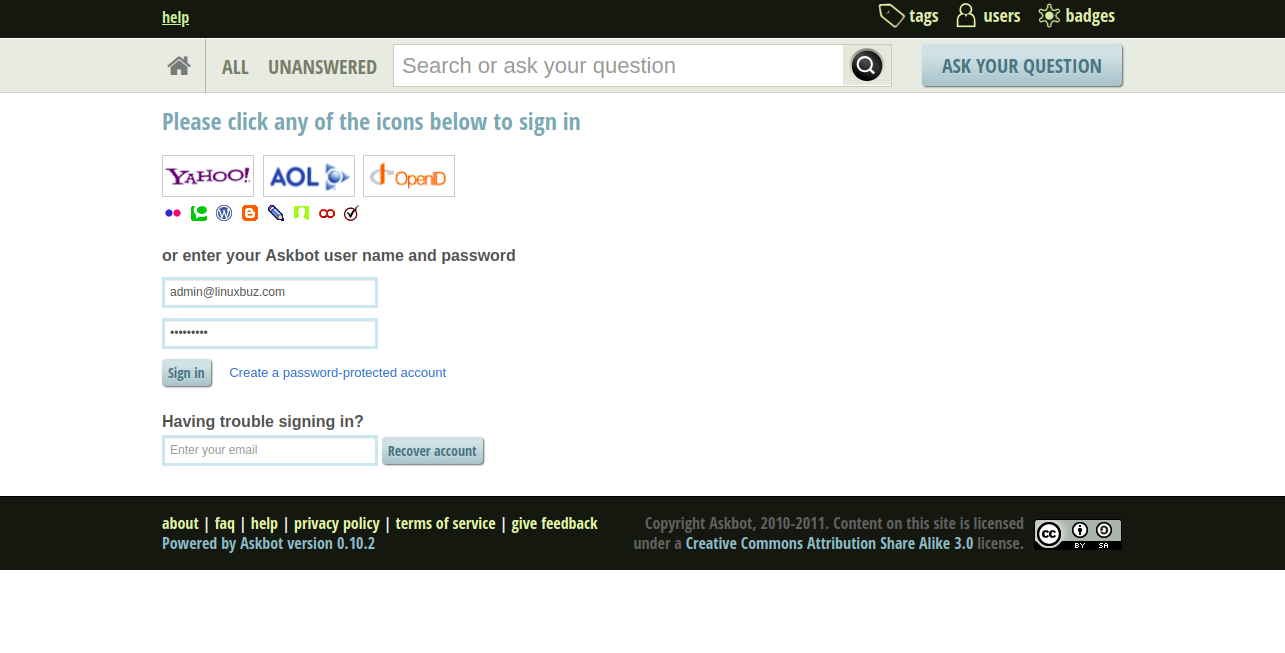Askbot is a free, open-source, and highly-customizable question-and-answer forum software written in Python and Django. It is simple, lightweight, and closely resembles other popular forum software like StackOverflow and Yahoo! Answers. Askbot boasts a variety of features including tags and categories, email notifications, a karma-based system, voting, content moderation, and more.
This tutorial will guide you through installing Askbot forum software on CentOS 8 with Let’s Encrypt SSL.
Prerequisites
- A server running CentOS 8.
- Root access configured on your server.
Install Required Dependencies
Start by installing the necessary dependencies for your system.
First, install the “Development Tools” with the command:
dnf group install 'Development Tools'
Next, install the EPEL repository and other Python dependencies using:
dnf install epel-release -y
dnf install python2-pip python2-devel python2-six -y
With all required packages installed, you can proceed to the next step.
Install and Configure PostgreSQL
Askbot utilizes PostgreSQL for data storage. Begin installation with:
dnf install postgresql-server postgresql-devel postgresql-contrib -y
Initialize the database:
postgresql-setup initdb
Next, start the PostgreSQL service and enable it to start on boot:
systemctl start postgresql
systemctl enable postgresql
Login to the PostgreSQL shell and set up the database:
su - postgres
psql
Create a database and user for Askbot:
create database askbot;
create user askbot with password 'password';
Grant privileges to the new user:
grant all privileges on database askbot to askbot;
Exit PostgreSQL shell:
\q
Edit the PostgreSQL configuration to set user authentication:
nano /var/lib/pgsql/data/pg_hba.conf
Replace “peer” with “md5” as shown:
local all all md5
host all all 127.0.0.1/32 md5
host all all ::1/128 md5
Restart PostgreSQL to apply changes:
systemctl restart postgresql
Install and Configure Askbot
Create an Askbot system user:
useradd -m -s /bin/bash askbot
passwd askbot
Add the Askbot user to the wheel group for sudo access:
usermod -a -G wheel askbot
Install Python virtualenv:
pip2 install virtualenv six
Switch to Askbot user and create a virtual environment:
su - askbot
virtualenv askbot
Activate the virtual environment:
cd askbot
source bin/activate
Install Askbot and dependencies:
pip2 install six==1.10.0
pip2 install askbot psycopg2
Create and set up your Askbot application:
mkdir myapp
cd myapp
askbot-setup
Follow the prompts, selecting PostgreSQL, and enter the respective database details. Generate static files and initialize the database:
python manage.py collectstatic
python manage.py syncdb
Install and Configure uWSGI
Install uWSGI:
pip2 install uwsgi
Create a uWSGI configuration file:
nano /etc/uwsgi/sites/askbot.ini
Use the following configuration:
[uwsgi]
chdir = /home/askbot/askbot/myapp
home = /home/askbot/askbot
static-map = /m=/home/askbot/askbot/myapp/static
wsgi-file = /home/askbot/askbot/myapp/django.wsgi
master = true
processes = 5
# Run Askbot under a socket file
socket = /run/uwsgi/askbot.sock
chmod-socket = 664
uid = askbot
gid = nginx
vacuum = true
# uWSGI Log file
logto = /var/log/uwsgi.log
Create a Systemd Service File for uWSGI
Create a systemd service file for uWSGI:
nano /etc/systemd/system/uwsgi.service
Add the following configuration:
[Unit]
Description=uWSGI service
[Service]
ExecStartPre=/bin/bash -c 'mkdir -p /run/uwsgi; chown askbot:nginx /run/uwsgi'
ExecStart=/bin/uwsgi --emperor /etc/uwsgi/sites
Restart=always
KillSignal=SIGQUIT
Type=notify
NotifyAccess=all
[Install]
WantedBy=multi-user.target
Reload the systemd daemon:
systemctl daemon-reload
Install and Configure Nginx
Install Nginx with:
dnf install nginx -y
Create a virtual host configuration for Askbot:
nano /etc/nginx/conf.d/askbot.conf
Use the configuration:
server {
listen 80;
server_name askbot.linuxbuz.com;
location / {
include uwsgi_params;
uwsgi_pass unix:/run/uwsgi/askbot.sock;
}
}
Start and enable Nginx and uWSGI:
systemctl start nginx
systemctl enable nginx
systemctl start uwsgi
systemctl enable uwsgi
Secure Askbot with Let’s Encrypt SSL
Install the Certbot utility for Let’s Encrypt SSL:
wget https://dl.eff.org/certbot-auto
mv certbot-auto /usr/local/bin/certbot-auto
chown root /usr/local/bin/certbot-auto
chmod 0755 /usr/local/bin/certbot-auto
Obtain and install an SSL certificate:
certbot-auto --nginx -d askbot.linuxbuz.com
Configure Firewall and SELinux
Open HTTP and HTTPS services on the firewall:
firewall-cmd --permanent --add-service=http
firewall-cmd --permanent --add-service=https
firewall-cmd --reload
Disable SELinux for Askbot by editing the /etc/selinux/config file and setting:
SELINUX=disabled
Restart your system to apply changes.
Access Askbot
Open your browser and visit https://askbot.linuxbuz.com to access Askbot. You will encounter an interface similar to this:

Click on the Sign In button to log in:

Enter your Askbot admin username and password to access the dashboard:

Conclusion
Congratulations! You have successfully installed and configured the Askbot forum on CentOS 8 and secured it with Let’s Encrypt SSL. You can now start creating a question-and-answer community using Askbot.
FAQ
What is Askbot?
Askbot is an open-source question-and-answer forum software designed to resemble platforms like StackOverflow and Yahoo! Answers. It is written in Python and Django and offers a range of features for community engagement and moderation.
Why use PostgreSQL with Askbot?
PostgreSQL is a powerful, open-source object-relational database system that offers robust functionality and performance. It’s ideal for use with Askbot due to its reliability and scalability, ensuring efficient data storage and retrieval.
Is it necessary to disable SELinux for Askbot?
Disabling SELinux may be necessary if you encounter permission issues with Askbot. However, it’s generally advisable to configure SELinux properly for enhanced security, adjusting only the necessary permissions for Askbot to function correctly.
How does Let’s Encrypt SSL enhance security?
Let’s Encrypt SSL provides HTTPS encryption, which secures data transmitted between the server and clients. This encryption is crucial for protecting user data and enhancing the overall security of your Askbot site.
